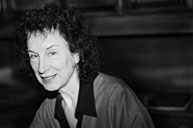Margaret Atwood: Back to the future
Margaret Atwood: Back to the future McGill University
User Tools (skip):
Margaret Atwood: back to the future
Interviewing Margaret Atwood, in theory, can be an intimidating experience for a writer of any kind. The undisputed queen of CanLit has authored 11 critically acclaimed novels, several volumes of poetry, short stories and non-fiction works. Some call her a best-selling legend.
 Author Margaret Atwood was named Person of the Year by the McGill Centre for the Research and Teaching on Women
Author Margaret Atwood was named Person of the Year by the McGill Centre for the Research and Teaching on WomenPhoto: Claudio Calligaris |
|
We meet midmorning on April 28 at the Omni Hotel, where later that night she'll be named Person of the Year by the McGill Centre for the Research and Teaching on Women, as part of a $250 per plate gala. "I'm the fundraiser," she says, simply. Before dinner, she's interviewed in front of an audience by CBC radio's Eleanor Wachtel, host of "Writers and Company," about her new sci-fi novel, Oryx and Crake.
Her last novel, The Blind Assassin, won a Booker prize. Her page-turning predecessor, Alias Grace, triumphed with a Giller and will soon be spun into a movie with actress Cate Blanchet.
In person, the literary trailblazer is smart and witty -- comparable to the many women she's created in her novels. She intermingles funny remarks with quotes from Swift to Shakespeare, a throwback to her days as an English literature professor at various universities.
Her blue eyes mesmerized this reporter, and in conversation she reveals her encyclopaedic knowledge of science, pop culture and current events. Her curiosity, she says, was sparked at home as a child. Her father is a botanist and her older brother is a neurophysicist. She dubs them, "The scientists."
Yet it comes as a surprise, while discussing her MCRTW accolade and latest novel, when she quizzes her interviewer about everything from ulcers to amoebas.
"If you have an amoeba that divides in two every second, put it in a test tube full of amoeba food, at what point will the test tube be half full of amoebas and half full of amoeba food?" she asks, when questioned about her fears concerning the world's overpopulation, "The answer: one second before the hour."
The amoeba query illustrates Atwood's quirky nature and love of teaching. It's not surprising that Oryx and Crake is her most informative novel ever. It's also her scariest.
Atwood's latest is a dystopia. Oryx and Crake features the remains of our over-inhabited, over-taxed planet, where global warming has withered landscapes, where pigs are used to grow human organs and over-commercialization has fostered mad science.
One scientist gone wrong, in turn, obliterates humanity save one person. Jimmy, or Snowman, is spared to fend among a new race of engineered successors.
Atwood says her vision of the future isn't that farfetched. "It's coming and then some," she says. "The world is finite. For everybody in the world to have the same lifestyle that we [in the West] have now, at only six billion people, would take four additional Earths [in resources]."
Although she refuses to say Oryx and Crake is a wakeup call for the world. While the book is "extreme," she says, "It's a novel. It's not an instruction manual. It's not an editorial."
If readers are shocked at her tome, Atwood counters, glow-in-the-dark rabbits and organ-growing pigs have been featured in her daily paper. She has a box of clippings to prove it.
"They're on the way," she says, noting she has no moral qualms about pigs being used for such devices. "It's a pig. I'm just not sure about eating the bacon afterwards."
Atwood is more concerned about educating women on population control. "If you educate women worldwide, then you don't have women having 12 children," she says. "Since we're about to hit 10 billion people in 2050, this is now key."
Another critical step for humanity will be the advent of new technologies to facilitate life. "Not only rich people should have access to those technologies," she says, unlike what occurs in her novel. "If so, we're in trouble."
Atwood says we must think globally. "A really good example of why you shouldn't commercialize everything is the SARS epidemic. If public health were something that had to be paid for by an individual, the thing would be all over the place by now. Our world is not made of watertight compartments."
In writing Oryx and Crake, Atwood's goal was to get people asking themselves two important questions: "Who are we as human beings and how do we want to live."
Choices will come along soon, she says. "We hope that we will make the informed ones. We hope that we will not commercialize bloody everything. We hope that there will be watchdogs in place to keep things from getting out of hand."
After reading Oryx and Crake, however, don't go thinking Atwood is a pessimist. "The future is of great, great concern to anybody who gives it five minutes of thought," she says, stressing she's doesn't stay awake at night worrying about her writings coming to life. "I'm remarkably worry-free."
For a list of non-fiction companion reads to Atwood's latest novel, please consult www.oryxandcrake.com.

